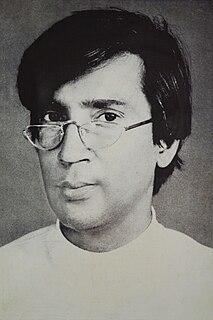 W
WZainul Abedin was a Bangladeshi painter. He became well known in 1944 through his series of paintings depicting some of the great famines in Bengal during its British colonial period. After the Partition of Indian subcontinent he moved to East Pakistan. In 1948, he helped to establish the Institute of Arts and Crafts at University of Dhaka. The Indian Express has described him as a legendary Bangladeshi painter. Like many of his contemporaries, his paintings on the Bengal famine of 1943 are viewed as his most characteristic works. His homeland honored him with given the title “Shilpacharjo” “Great teacher of the arts" for his artistic and visionary attributes. He was the pioneer of the modern art movement that took place in Bangladesh and was rightly considered by Syed Manzoorul Islam as the founding father of Bangladeshi modern arts, soon after Bangladesh earned the status of an independent republic.
 W
WMaksudul Ahsan is a Bangladeshi artist and poet.
 W
WMurtaja Baseer was a Bangladeshi painter and artist known for his abstract realism themed works. He was also a poet, author, researcher, numismatist, and filmmaker. He was awarded the Ekushey Padak, Bangladesh's second highest civilian honor, in 1980, and the Swadhinata Padak, or Independence Day Award, Bangladesh's highest state award, in 2019.
 W
WRashid Hossain Choudhury was a Bangladeshi second generation artist, sculpture, writer and professor. He played a major part in the progress of art movements and improvement in the art-related educational institutions in this country. For his creative endeavor and innovative influence, he has been highly praised. During the 1950s, he had been a significant pioneer in the modern art movement.
 W
WQuamrul Hassan was a Bengali artist. Hassan is often referred to in Bangladesh as Potua, a word usually associated with folk artists, due to his down to earth style yet very modern in nature as he always added Cubism other than the folk style to his artworks. In addition to his artistic legacy, two of Hassan's work have come to be part of Bangladesh's political history. The first of this is a monstrous rendition of Yahya Khan, the Pakistani president who ordered genocide in Bangladesh. The second was just before his death, mocking the then dictator of Bangladesh, Hossain Mohammad Ershad. This sketch was titled Desh aaj bisshobeheyar khoppre.
 W
WSyed Jahangir was a Bangladeshi painter. He was awarded Ekushey Padak by the Government of Bangladesh in 1985. He served as the department head of the Arts Faculty at Shilpakala Academy in 1977. His notable paintings include Attmar Ujjibon, Ullas, Dhoni, Ojana-Oneshya and Osoni-Sangket.
 W
WNitya Gopal Kundu was a Bangladeshi artist, sculptor and entrepreneur. Kundu played an important role during the liberation war of Bangladesh in 1971. He founded the furniture company Otobi.
 W
WNajib Tareque, is a Bengali artist, printmaker and writer based on Dhaka, Bangladesh. He is best known for her New media artworks and one of the pioneers of online art galleries in Bangladesh. Tareque was the founding member of Jolrong, one of the first online art galleries in South Asia. Since 1987, he has been part of various group and solo exhibitions both in the country and abroad. He participates more than twenty individual and joint exhibitions in the country and abroad.